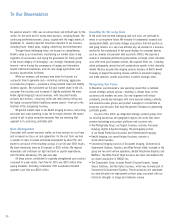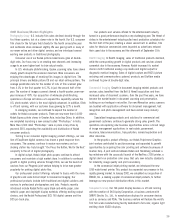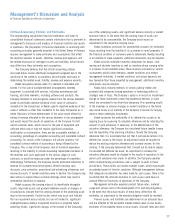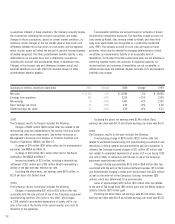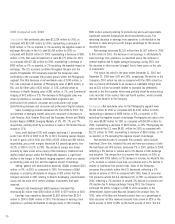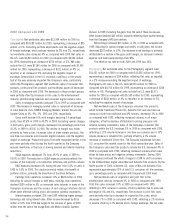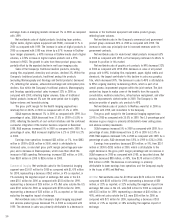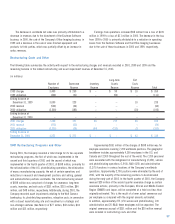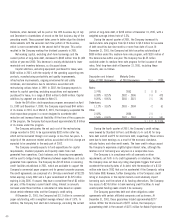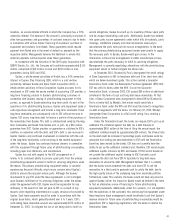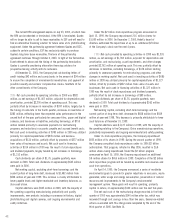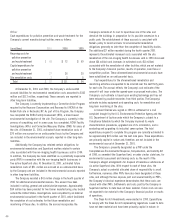Kodak 2001 Annual Report Download - page 36
Download and view the complete annual report
Please find page 36 of the 2001 Kodak annual report below. You can navigate through the pages in the report by either clicking on the pages listed below, or by using the keyword search tool below to find specific information within the annual report.
34
2000 Compared with 1999
Consolidated Net worldwide sales were $13,994 million for 2000 as
compared with $14,089 million for 1999, representing a decrease of $95
million, or 1%. Excluding portfolio adjustments and the negative impact
of foreign exchange, which reduced revenue by 2% and 3%, respectively,
net worldwide sales increased 4% as compared with 1999. Net sales in
the U.S. were $6,810 million for 2000 as compared with $6,594 million
for 1999, representing an increase of $216 million, or 3%. Net sales
outside the U.S. were $7,184 million for 2000 as compared with $7,495
million for 1999, representing a decrease of $311 million, or 4% as
reported, or an increase of 2% excluding the negative impact of
exchange. Deterioration in the U.S. economic conditions in the second
half of the year adversely impacted the Company’s sales, particularly
within the Photography segment. Net worldwide sales of consumer film
products, professional film products and traditional paper all decreased
in 2000 as compared with 1999. The decreases in these product groups
were partially offset by increases in film sales to the entertainment
industry, photofinishing revenues and consumer digital camera sales.
Sales in emerging markets increased 7% in 1999 as compared with
2000. The increase in emerging market sales is comprised of increases
in Latin America, Asia, EAMER Emerging Markets, Greater Russia and
Greater China of 3%, 9%, 2%, 39% and 10%, respectively.
Gross profit declined 6% with margins declining 2.4 percentage
points from 42.6% in 1999 to 40.2% in 2000. Excluding special charges
in both years, gross profit margins decreased 2.8 percentage points from
43.3% in 1999 to 40.5% in 2000. The decline in margin was driven
primarily by lower prices, increased sales of lower margin products, like
one-time-use cameras and consumer digital cameras, and the negative
impact of exchange. Productivity gains that were recognized earlier in the
year were partially offset during the fourth quarter as the Company
reduced inventories in the face of slowing demand and retailer inventory
reductions.
SG&A expenses decreased 7% from 19.2% of sales in 1999 to
18.0% in 2000. The reduction in SG&A expenses primarily reflects the
success of the Company’s cost-reduction initiatives and portfolio actions.
R&D expenses decreased 4% during the year from 5.8% of sales in
1999 to 5.6% in 2000. This decline primarily reflects the benefit of
portfolio actions, primarily the divestiture of Eastman Software.
Earnings from operations increased 11% or $224 million in 2000.
Adjusting for special charges in both years, earnings from operations
declined $190 million or 8% as increased sales volumes in many of the
Company’s businesses and the success of cost-savings initiatives did not
offset lower effective selling prices and adverse currency movements.
Interest expense increased 25% over 1999 reflecting higher average
borrowings and rising interest rates. Other income decreased by $165
million or 63% from 1999 due largely to the inclusion of gains of $120
million from the sale of the Image Bank and Motion Analysis Systems
Division in 1999. Excluding the gains from the sale of these businesses,
other income declined $45 million, primarily reflecting lower equity earnings
from the Company’s KPG joint venture.
Net earnings increased $15 million, or 1%, in 2000 as compared with
1999. Adjusting for special charges and credits in both years, net income
decreased $323 million, or 19%. The decrease in net earnings is primarily
attributable to a decline in the gross profit margin, an increase in interest
expense, and lower equity earnings from KPG.
The effective tax rate for both 2000 and 1999 was 34%.
Photography Net worldwide sales for the Photography segment were
$10,231 million for 2000 as compared with $10,265 million for 1999,
representing a decrease of $34 million, reflecting flat sales as reported,
or a 3% increase excluding the negative impact of exchange.
Photography net sales in the U.S. were $4,960 million for 2000 as
compared with $4,756 million for 1999, representing an increase of $204
million, or 4%. Photography net sales outside the U.S. were $5,271
million for 2000 as compared with $5,509 million for 1999, representing
a decrease of $238 million, or 4% as reported, or an increase of 2%
excluding the negative impact of exchange.
Net worldwide sales of the Company’s consumer film products,
which include traditional 35mm film, Advantix film and one-time-use
cameras in both the traditional and APS formats, decreased 1% in 2000
as compared with 1999, reflecting increased volumes in all major
categories, offset by declines attributable to pricing pressures and
adverse currency movements. Sales of the Company’s consumer film
products within the U.S. increased 2% in 2000 as compared with 1999,
reflecting a 17% volume increase in one-time-use cameras and a 15%
volume increase in Advantix film, partially offset by a 2% volume
decrease in traditional 35mm film. The Company maintained full-year
U.S. consumer film market share for the third consecutive year. Sales of
the Company’s consumer film products outside the U.S. decreased 4% in
2000 as compared with 1999, reflecting increased volumes which were
offset by lower prices and negative currency movements. During 2000,
the Company continued the efforts it began in 1998 to shift consumers
to the differentiated, higher value Max and Advantix film products. By the
fourth quarter of 2000, combined U.S. sales of Max and Advantix films
represented approximately 62% of total U.S. consumer roll film revenues,
up 6 percentage points as compared with the year-end 1999 level.
Net worldwide sales of origination and print film to the
entertainment industry increased 4% in 2000 as compared with 1999.
Print film sales increased 10% in 2000 as compared with 1999,
reflecting a 20% increase in volume, offset by declines due to price and
exchange of 6% and 4%, respectively. The increase in print film sales
were partially offset by a decrease in origination film sales, which
decreased 1% in 2000 as compared with 1999, reflecting a 2% increase
in volume offset by a 3% decline due to foreign exchange. The net sales


